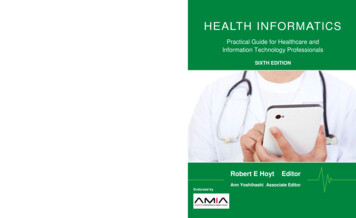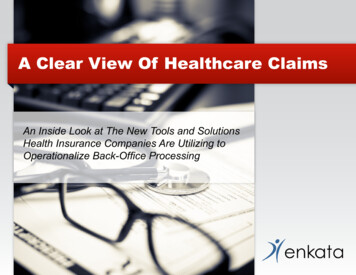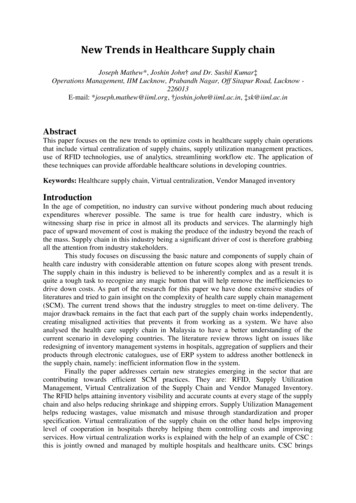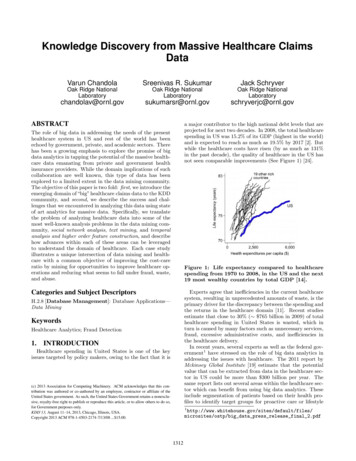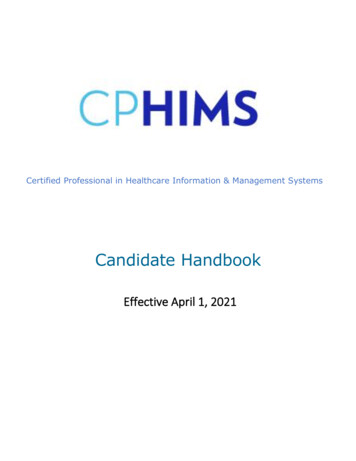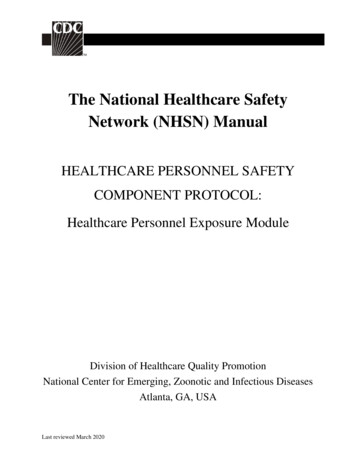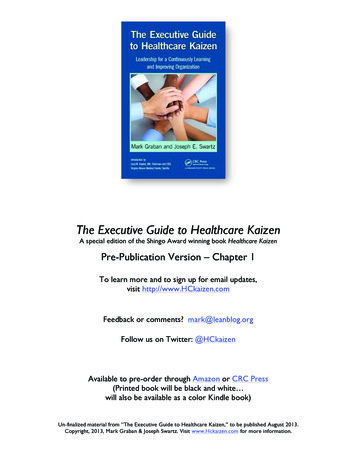
Transcription
The Executive Guide to Healthcare KaizenA special edition of the Shingo Award winning book Healthcare KaizenPre-Publication Version – Chapter 1To learn more and to sign up for email updates,visit http://www.HCkaizen.comFeedback or comments? mark@leanblog.orgFollow us on Twitter: @HCkaizenAvailable to pre-order through Amazon or CRC Press(Printed book will be black and white will also be available as a color Kindle book)Un-finalized material from “The Executive Guide to Healthcare Kaizen,” to be published August 2013.Copyright, 2013, Mark Graban & Joseph Swartz. Visit www.Hckaizen.com for more information.
About this BookThis book (The Executive Guide to Healthcare Kaizen) is a follow-up edition toour book Healthcare Kaizen: Engaging Front-Line Staff in Sustainable ContinuousImprovements. This book, a derivative of that earlier work, is intended for seniorleaders and other healthcare leaders who can initiate and sponsor a Kaizen programof staff engagement and continuous improvement for their organization.Healthcare Kaizen is a longer book, with over 200 full-color illustrations,including 100 examples of real Kaizen improvements from different healthcareorganizations. We, thankfully, received many positive reviews of the book, withthe only real criticism being that the book was too complete or too heavy for anexecutive to carry onboard a flight.This edition is intended to cover the “why” (why Kaizen?) and the “what”(what is Kaizen and a Kaizen culture?), while Healthcare Kaizen has more of the“how.” There is significant overlap between this book and Healthcare Kaizen,so there is a consistent approach taught by both books. We envision The ExecutiveGuide to Healthcare Kaizen as a smaller, more affordable, book that covers thebasics of Kaizen, while Healthcare Kaizen is the more encyclopedic guide forpractitioners.Each chapter in this book starts with a “quick take” list of key points from thechapter. At the end of each chapter are discussion questions that we hope you willuse to prompt discussion with your leadership team. We invite you to interact withus via our website, http://www.HCkaizen.com.While this book has two coauthors, Mark Graban and Joe Swartz, we havedone our best to write in a single voice. Any work that we directly participatedin is written about in the third person to avoid confusion about who was writingparticular sections.Franciscan St. Francis Health is a three-hospital system in Indianapolis.Throughout this book, we will often refer to individual hospitals in this systemin an abbreviated form like “Franciscan.” That three-hospital system is part ofthe Franciscan Alliance, a 14-hospital system located throughout Indiana andnortheastern Illinois. Where we focus on one of their other 11 hospitals, we willcall them out uniquely, such as Franciscan St. Elizabeth Health.xxix
Book Comparisons:Visit www.HCkaizen.com for more information
Chapter Comparisons:Visit www.HCkaizen.com for more information
To view a 3-minute video about the practice ofHealthcare Kaizen at the Franciscan St. Francis HealthSystem, including comments from their CEO, BobBrody, and their COO, Keith Jewell, hcare Kaizen was named a recipient of theprestigious Shingo Professional Publication andResearch Award in 2013. Learn more at:http://www.HCkaizen.com/ShingoAwardVisit www.HCkaizen.com for more information
IntroductionThe value of using Kaizen to improve healthcare systems is indisputable. At VirginiaMason, we have been using Kaizen, based on the Toyota Production System, formore than a decade. The Virginia Mason Production System, as we call it, hasallowed us to deliver safer, better, and more affordable care to our patients.One of the keys to successful implementation of Kaizen is the serious commitment of leaders – including the CEO, senior executives, physician leaders, andboards of directors. In our organization, all leaders attend mandatory Kaizen training, are required to lead formal improvement events each year, and are expectedto routinely coach and train employees about how to improve their work usingKaizen tools and methods. Kaizen is not a program or an activity that is the soleresponsibility of one department; it is the management method used by all leadersat Virginia Mason to guide and operate every aspect of the organization.Physician leadership is an important part of leadership commitment. An organization that reforms around physicians but doesn’t involve them in the process willhave difficulty succeeding in the long run. In my experience, the organizations withstrong physician leadership and active physician involvement at all levels are bestprepared to deliver change through Kaizen.Kaizen tools encourage and guide change in day-to-day work by all employees. As employees gain a better understanding of Kaizen, they use its methods toimprove how they do their work. At Virginia Mason, we encourage employees torecord their improvement ideas as “Everyday Lean Ideas” and share them with theorganization so they can be replicated across the medical center.As it relates to employee engagement, Kaizen can’t be imposed from above.Leaders should introduce, teach, and encourage the adoption of Kaizen methodologies, but it is only sustained when employees are engaged—because they have foundthat it makes their work easier and more satisfying. Employees become championsof Kaizen when they see it reduces the burden of work and the waste of reworkand waste of time that come with inefficiency. It frees them to do the importantthings that add value for our patients and helps them recapture the passion thatdrove their original career decisions to work in healthcare.xxxi
xxxii IntroductionLearning to use Kaizen consistently and effectively requires serious culturechange and takes many years. This is really not unexpected, as using Kaizen requiresdeep organizational changes—changes that challenge long-held beliefs and manyaccepted practices. Our results have been gratifying and propel us to work evenharder to deploy these methods and tools deeply within our organization. I believethis book will help any willing healthcare leader who sets out on the Kaizen journeyto achieve similar success.Gary S. Kaplan MDChairman and CEO, Virginia Mason Medical Center, Seattle
About the AuthorsMark Graban is an author, consultant, and speakerin the field of Lean healthcare. He is the author ofLean Hospitals: Improving Quality, Patient Safety,and Employee Engagement (2nd edition) and coauthor of Healthcare Kaizen: Engaging Front-LineStaff in Sustainable Continuous Improvements. Markhas worked as a consultant and coach to healthcare organizations throughout North America andEurope. He was formerly a senior fellow with theLean Enterprise Institute and continues to serve as afaculty member. Mark is also the chief improvementofficer for KaiNexus, a startup software company thathelps healthcare organizations manage continuousimprovement efforts. Mark earned a BS in industrialengineering from Northwestern University and an MS in mechanical engineeringand an MBA from MIT Sloan Leaders for Global Operations Program. Visit hiswebsite at http://www.MarkGraban.com and his blog at http://www.LeanBlog.org.Joseph E. Swartz is the director of BusinessTransformation for Franciscan St. Francis Healthof Indianapolis, Indiana. He has been leading continuous improvement efforts for 18 years, including7 years in healthcare, and has led more than 200Lean and Six Sigma improvement projects. Joseph isthe coauthor with Mark Graban of Healthcare Kaizen:Engaging Front-Line Staff in Sustainable ContinuousImprovement and coauthor of Seeing David in the Stoneand was previously an instructor at the University ofWisconsin. Joseph earned an MS in managementfrom Purdue University as a Karnnert Scholar for academic excellence.xxxiii
Chapter 1The Need for KaizenQuick Take Because healthcare faces such great challenges, we have no choice but to geteverybody involved in identifying and implementing improvements. Kaizen is a Japanese word that means “change for the better.” Kaizen is a key part of the Lean management philosophy and strategy. Kaizen engages all staff, physicians, and leaders in making improvements tosafety, quality, access, and cost, while improving staff morale. Responsibility for Kaizen cannot be outsourced to consultants or delegatedto a Quality Department. Kaizen creates higher engagement, which leads to better quality, whichresults in lower cost. The return on Investment (ROI) on a Kaizen program can be impressive(millions per year with little investment). Kaizen creates more a more flexible and adaptive organization, to better copewith conditions of extreme uncertainty.It is not the strongest of the species that survives, nor the most intelligent, but the one most responsive to change.—Charles DarwinFranciscan St. Francis Health is a three-hospital system in Indianapolis, Indiana,that is part of the Franciscan Alliance, a 13-hospital system located throughoutIndiana and northeastern Illinois. Founded over 135 years ago by a group of1Final edits not done yet - pre-publication copy
2 The Executive Guide to Healthcare KaizenCatholic Sisters, they take their inspiration from St. Francis of Assisi. FranciscanSt. Francis Health has received numerous awards, including: Number one ranking in Indiana by HealthGrades for cardiac servicesand one of America’s 100 best hospitals for cardiac care and coronaryintervention. Top 5% in the nation and number one in Indiana for joint surgery, accordingto HealthGrades, 2007–2011. The HealthGrades Distinguished Hospital Award for Clinical Excellence in2012 for being in the top 5% in the nation in overall clinical quality.In 2005, after several years of suboptimal performance, the organization wentlooking for ways to capitalize on its foundation of excellence.Paul Strange, MD, then Franciscan’s vice president of quality, convinced theleadership team to launch a Lean Six Sigma program. Robert J. Brody, presidentand chief executive officer of St. Francis Health, and Keith Jewell, the chief operating officer, brought in a team of people from the outside, including one of thisbook’s coauthors, Joe Swartz, and professors from Purdue University. Their LeanSix Sigma journey began in 2006, and Franciscan added a formal Kaizen programof continuous improvement in April 2007.What started small, with a housekeeping staff member improving the way coffee filters were stored, has turned into an organization-wide program and, moreimportantly, a significant culture change. Today, Franciscan St. Francis empowerstheir staff members to identify problems and take action, leading to improvementsboth large and small. Some of these improvements made life a little better for thepatients in a fun or charming way, some changed clinical practice, and others savedsignificant sums of money.Since 2007, the three Franciscan St. Francis hospitals have implemented morethan 17,000 improvements that have an estimated hard dollar cost savings of over 5.7 million, all with very little investment other than time, focus, and leadership. If every hospital in the United States could save 2 million a year throughKaizen, it would add up to 10 billion. That may seem like a small drop in thehealthcare cost bucket, but the hard numbers from Franciscan don’t include other“soft savings” such as staff time savings that can be reallocated to better patientcare, increased patient and staff satisfaction, reduced error rates, and reducedwaiting times.The cost savings at Franciscan have been impressive, but cost is far fromthe primary goal of Franciscan’s Kaizen culture. Throughout this book, wewill be sharing stories from Franciscan and other hospitals to demonstrate howthey engaged their staff in improvements that made a difference for all of theirstakeholders: patients, employees, physicians, and the organization itself. CEOBob Brody said, “There is every reason for any organization to encourage andsupport the Kaizen concepts. It creates a more efficient and productive work
The Need for Kaizen 3environment, a more satisfied patient, and a more satisfied workforce. These arelinked to one another, and to hospital performance.”1For Franciscan and other leading organizations, Kaizen is just the right thing todo in terms of furthering its mission and fulfilling its desire to treat all staff members, physicians, and other stakeholders with the utmost of respect.Kaizen Change for the BetterThe word Kaizen is translated from Japanese in a number of ways, most simply as“change for the better.”2 The Japanese characters are shown in Figure 1.1.Breaking down the word: Kai means “change,” zen means “good.”A Kaizen is an improvement that is made by those who do the work. It istypically a small, low-cost, low-risk improvement that can be easily implemented.3Kaizen is an ongoing methodology and philosophy for challenging and empowering everyone in the organization to use their creative ideas to improve theirdaily work.The word Kaizen, the way it is typically used, is synonymous with the phrasecontinuous improvement. An effective Kaizen approach is connected to measurable results and a deeper purpose. Children’s Medical Center (Dallas, Texas)has a process improvement campaign that asks the simple question, “Is there abetter way?” Clay York, manager of the core laboratory, and other leaders helptie the department’s local improvement efforts to the organization’s mission andpurpose by asking team members if proposed changes will help provide “bettercare for kids.”4Figure 1.1 The word Kaizen in Japanese kanji characters.
4 The Executive Guide to Healthcare KaizenBeyond the measurable results, Kaizen organizations value theorganizational learning that results from the improvement process, as well as the personal learning and satisfaction of allwho are involved.IU Health Goshen Hospital has saved more than 30 millionsince 1998 with a program called “The Uncommon Leader” aspart of its broader improvement program. In 2009, CEO JamesDague, now retired, promised to shave his head if employeesgenerated ideas that saved 3.5 million that year. The hospitalmore than doubled that savings goal, so Dague made good onthat promise in front of his colleagues. The culture at Goshenhas shifted to one where every person is empowered to makeimprovements to his or her daily work, making suggestionsthat can impact cost, quality, and patient care. For example,an emergency nurse educator saved 4,000 by changing thetype of napkins used on patient trays and the GI departmentsaved 22,000 by switching from disposable paper gownsto cloth gowns.5 Goshen has gone 17 years without layoffs,undoubtedly being a key reason its employees are so enthusiastic about improvement.6 Goshen was also named one of thetop ten large employer workplaces in Indiana, in part due to its“workplace culture where employees feel valued.”7Kaizen Meaningful ImprovementsPaula Stanfill’s husband had open-heart surgery. Paula is the manager of the neonatal intensive care unit (NICU) at Franciscan St. Francis Health. In the recoveryroom, Paula’s husband could not speak because he was intubated with a breathingtube. He was trying to communicate by furrowing his eyebrows and squinting. Heknew sign language and was motioning at his arm and trying to use his fingers totell Paula something, but he could not make his hands do what he wanted them todo. Paula remembers her panic in realizing that something serious might be happening to her husband. He also began to panic, thinking the surgery had causeda serious problem with his arms. They were deeply distressed until the anesthesiawore off and he could speak again.Paula learned that her husband’s arms and hands were numb. He was a bigman, and when the surgeons performed the procedure, they had leaned over hisarms and put pressure on them, reducing the blood supply and causing the numbness. His arms remained numb for several weeks.After this episode, Jessica Clendenen, a nurse in Franciscan’s cardiac operating room, learned that several other patients had experienced similar postoperative
The Need for Kaizen 5numbness. She decided to do something about it. In January 2011, Jessica foundsome sled positioners that could be used to help tuck the patient’s arms in placein a way that allowed the IV lines to be seen through the clear material. The useof positioners reduced the pressure on the patient, which meant improved quality,patient safety, and satisfaction.This small, simple improvement can be described as a Kaizen. It was an improvement that made a difference to open-heart patients at Franciscan and was one thatPaula will never forget. When she started making workplace improvements, Paulanever realized it would touch her so personally. But after her husband’s experience,Paula realized that the heart of Kaizen is the difference it can make in people’s lives.Kaizen was no longer just a concept or a program to her; it had become a way of life.Healthcare’s Opportunity for ImprovementThe largest room in the world is the room for improvement.—Author unknownAs summarized in the Institute of Medicine’s 2012 report titled, Best Care at LowerCost: The Path to Continuously Learning Health Care in America, healthcare in theUnited States is underperforming in many ways, with problems including: 750 billion in “unnecessary health spending” in 2009 75,000 “needless deaths” that “could have been averted” in 2005 if every stateperformed as well as the best state8Of the 750 billion in waste, 130 billion is estimated to come from “inefficiently delivered services,” which includes mistakes, errors, and preventable complications, fragmented care, and operational inefficiencies.9 These costs are in the spanof control of health systems and represent a great opportunity for improvement.While healthcare spending in the United States is far higher than any othercountry, rising costs, along with costs that are too high for national budgets, are aproblem throughout the developed world. Diabetes costs alone “threaten to bankrupt” the National Health Service (NHS) in England10 and the NHS is beingforced to cut costs by 20 billion by 2015.11 The budget cuts are leading to nurselayoffs and warnings from some NHS finance staff that patient care “will suffer”as a result.12 Hospitals in Canada face government budget cuts, as public healthcare costs could comprise 70% of the Ontario provincial budget by 2022.13 MichelTétreault, CEO of St. Boniface General Hospital (Winnipeg, Manitoba), says hishospital has to, each year, deliver care to 4% more patients who are 4% sicker withthe same staffing and resources.14With American hospitals now facing the additional financial pressures of thePatient Protection and Affordable Care Act of 2010, also known as ObamaCare,
6 The Executive Guide to Healthcare Kaizenreimbursements to health systems and physicians are being reduced, while penaltiesfor preventable medical errors and readmissions are increasing.The Institute of Medicine (IOM) report concluded that, “Left unchanged,health care will continue to underperform; cause unnecessary harm; and strainnational, state, and family budgets.”15 Patients and their families are a powerfulmotivation for improving quality and safety, reducing costs, and improving access.Beyond the financial strain, there is also a big need to reduce the workplace strainand stress on physicians, nurses, and staff members in all departments. This stressand frustration is caused primarily by process issues that can be fixed by healthcareorganizations—and can often be fixed by local teams, if they have a method forimprovement and a conducive environment.Today’s health system executives, around the world, face the challenge of simultaneously improving across many dimensions. The old trade-offs can no longerhold true—the notion that better quality must inherently cost more or that theonly way to increase capacity is spending more money on people, resources, andfacilities. Leaders must figure out how to bust these old trade-offs and this requiresnew approaches. When facing large challenges, the most effective approach might,ironically, begin with the smallest of steps.Small improvements are believable and therefore achievable.16—Tony RobbinsThe IOM’s Recommendations for Continuous LearningThe IOM report highlighted the need for “continuously learning” and “continuously improving” healthcare organizations. They directly endorse the use of Lean,Six Sigma, and other methods17 and their more detailed recommendations includemany aspects of a Kaizen approach, such as: Recommendation 6: Care continuity. Improve coordination and communication within and across organizations. Recommendation 7: Optimized operations. Continuously improve healthcare operations to reduce waste, streamline care delivery, and focus on activities that improve patient health. Recommendation 10: Broad leadership. Expand commitment to the goals ofa continuously learning health care system.18The IOM elaborates that the characteristics of a continuously learning organization include “a leadership-instilled culture of learning” where a system is“stewarded by leadership committed to a culture of teamwork, collaboration, andadaptability in support of continuous learning as a core aim.”19 The IOM alsoenvisions a learning health system as one in which “complex care operations and
The Need for Kaizen 7processes are constantly refined through ongoing team training and skill building,systems analysis and information development, and creation of the feedback loopsfor continuous learning and system improvement.”20 That all describes Kaizen andthat is becoming the culture of Franciscan and other leading health systems.The idea of a learning organization is not new, as the term has been used fordecades by the quality guru W. Edwards Deming and his followers, as well as thesystems thinking field popularized by MIT professor Peter Senge. Many health systems have found that Lean and Kaizen methods and principles can create a learningorganization.21 In increasingly uncertain times, the organizational ability to learn,improve, and adapt will be helpful, if not absolutely necessary.Dr. Berwick’s Early Call for Kaizen in HealthcareThe word Kaizen was introduced to the West by Japanese author and consultantMasaaki Imai in his 1986 book KAIZEN: The Key to Japan’s Competitive Success. Imaiwrote simply, “Kaizen means improvement” and “Kaizen is everybody’s business.”22Shortly after Imai’s book, other healthcare leaders took notice. Dr. DonaldM. Berwick is legendary in healthcare quality and patient safety improvementcircles, thanks to his advocacy and education work done as the founder and chairman of the Institute for Healthcare Improvement and as the former administratorof the U.S. Centers for Medicare and Medicaid Services. In 1989, Berwick published an article called “Continuous Improvement as an Ideal in Health Care” inthe New England Journal of Medicine, where he wrote that continuous improvement“holds some badly needed answers for American health care.”23Berwick cited Imai with the definition that Kaizen is “the continuous searchfor opportunities for all processes to get better” and emphasizing that the selfdevelopment and the pursuit of completeness found in Kaizen are “familiar themesin medical instruction and history.” In highlighting what is different with Kaizen,Berwick criticized disciplinarian-style leaders who look to punish “bad apples”instead of improving processes. He also argued that a leader cannot be “a mereobserver of problems,” but instead needs to lead others toward solutions.Berwick highlighted a number of themes, including: Leaders must take the lead in continuous quality improvement, replacingblame and finger pointing with shared goals. Organizations must invest managerial time, capital, and technical expertisein quality improvement. Respect for healthcare professionals must be reestablished, highlighting thatthey are assumed to be trying hard, acting in good faith; “people cannot befrightened into doing better” in complex healthcare systems.Berwick’s summary of continuous improvement emphasized the culture changerequired to have everybody work together—removing fear, shame, and finger
8 The Executive Guide to Healthcare Kaizenpointing from the healthcare system. Many organizations post statements aboutcontinuous improvement on their websites or on lobby signs. Unfortunately, evenin 2012, too many of those statements reflect aspirations rather than reality.The Impact of Kaizen at Franciscan St. FrancisAt Franciscan, the adoption of Kaizen grew gradually, yet impressively, over thefirst few years since the launch of the Kaizen program in 2007. In the year 2011,41% of the staff had participated during that year, and 53% of the staff had participated sometime since the launch. In 2011, 82% of all departments had at leastone person participate in Kaizen. The growth in employee participation is shownin Figure 1.2, including a slight dip in 2012. Franciscan is working toward havingindividual participation rates reach 80% in a given year.As a benchmark, Toyota receives an average of 10 improvement ideas per personeach year, after decades of building their Kaizen culture.24 The number of Kaizensimplemented each year at Franciscan is shown in Figure 1.3, at a peak of 1.7 Kaizensper full-time equivalent in 2011. The number at Franciscan is significantly higherthan most healthcare organizations and they are working to increase participationeach year. In 2013 Franciscan is aiming for 5,000 Kaizens.% of Employees 020112012Figure 1.2 Percentage of employees at Franciscan St. Francis Hospitals with aformally submitted Kaizen in each year.
The Need for Kaizen 9# 012Figure 1.3 Number of formally completed and documented Kaizens each year.At Franciscan, the Kaizens in 2010 resulted in a total documented savings of over 3 million. Of that, about 1.7 million in savings was money that flowed directly tothe bottom line, and about 1.4 million of that was potential dollar savings through,for example, the saving of someone’s time. Beyond these documented savings are thebenefits from small Kaizens, where it is hard (or not worth the time) to calculate savings. The last 6 years of savings are shown in Figure 1.4. It should be noted that thecalculated cost savings were lower in 2011 and 2012, as staff was preoccupied withthe installation of a new electronic medical record system and the consolidation oftwo campuses into one. Basically, leaders did not push for a strong focus on costsavings in those two years, but there is a renewed cost focus in 2013.Again, bottom-line savings and return on investment (ROI) are not the onlythings that matter, but they are an important part of the picture for healthcareorganizations that are under significant financial pressures. Frontline staff at organizations like Franciscan haven’t formally been taught to translate what they dointo financial terms. They often don’t know the cost of the supplies they use, anhour of their time (fully burdened), or an hour of operating room time. The practice of Kaizen at Franciscan has helped educate staff to get them thinking in financial terms, in addition to (not instead of) everything they already focused on.The most significant benefit at Franciscan has been the difference Kaizen makesfor patients and staff, as this book and the additional examples in our companion book Healthcare Kaizen will demonstrate. The softer benefits related to patient
10The Executive Guide to Healthcare Kaizen 2,000,000 1,738,161 1,800,000 1,600,000EMR implementation 1,400,000 1,200,000 887,491 1,000,000 800,000 925,518ConsolidatedCampuses 667,238 600,000 356,875 400,000 190,000 200,000 2007Figure 1.420082009201020112012Bottom-line “hard” dollar savings for 2007–2012.safety, outcomes and satisfaction, along with staff safety, learning, and satisfaction,can be hard to quantify but cannot be emphasized enough.Baptist Health Care (Florida) has a Kaizen program called“Bright Ideas” that was established in 1995 to engage allemployees in improvement and innovation. Since 2008,every employee has had the expectation of implementingthree ideas per year that will improve patient outcomes, savetime, or improve safety. More than 50,000 ideas have beenimplemented since 2000, and although cost savings is not theprimary goal, there has been a total estimated cost savings andavoidance of 50 million. In 2008 alone, almost 14,000 ideaswere implemented, or more than two per employee, contributing 10.5 million in cost avoidance and 5.5 million in costsavings.25 Additionally, full-time voluntary turnover is relativelylow, at just 4% annually,26 and the system has been on theFortune 100 Best Places to Work for in America twelve of thelast fifteen years, including every year from 2003 to 2012.27
The Need for Kaizen 11It Is Not Always about CostThe most common types of Everyday Lean Ideas involve shaving timeoff a process. And when you think about the cost in health care one ofour most valuable resources is time.28—Virginia Mason Medical CenterThe aspect of Kaizen that excites some senior leaders is cost reduction, especially ina tough economic environment. This is very understandable. However, if too muchfocus is placed on cost savings, staff may get discouraged because they also want toimprove quality, safety, and waiting times, while creating a better workplace. Oneway to address this is for administration to recognize and share Kaizens with variedbenefits, not just those that reduce costs. At Franciscan, fewer than 6% of Kaizensare quantified and verified with finance personnel as directly saving bottom-linemoney for th
xxix About this Book!is book (!e Executive Guide to Healthcare Kaizen) is a follow-up edition to our book Healthcare Kaizen: Engaging Front-Line Sta" in Sustainable Continuous Improvements. !is book, a derivative of that earlier work, is intended for senior leaders and other healthcare leaders who can initiate and sponsor a Kaizen program of sta" engagement and continuous improvement for their .



